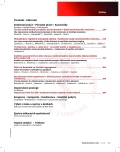Stability of complete blood count and microscopic differential count parameters
Authors:
E. Babuňková 1; P. Kačírková 2; M. Oupická 2; O. Babuněk 3; P. Salačová 2; M. Špaček 1
Authors‘ workplace:
Centrální hematologické laboratoře ÚLBLD, Všeobecná fakultní nemocnice v Praze
1; Laboratoř hematologie ÚLD, Fakultní nemocnice Královské Vinohrady, Praha
2; Fakulta ekonomická Západočeské univerzity v Plzni
3
Published in:
Transfuze Hematol. dnes,22, 2016, No. 4, p. 254-263.
Category:
Comprehensive Reports, Original Papers, Case Reports
Overview
Introduction:
Complete blood count (CBC) including the automated differential white blood cell count (WBC differential) represent a routine laboratory test. The time interval between sample collection and testing (sample stability) may have an important effect on the quality of test results. The aim of this study was to analyse changes in CBC (including new advanced parameters) and WBC differential performed both by a haematology analyser and microscopic examination at different storage temperatures over time, including qualitative morphological changes.
Materials and methods:
Data were obtained from 20 healthy volunteers (6 males/14 females) from whom 3 tubes with K3EDTA venous blood were taken. Blood samples were measured using the XE2100 haematology analyser (TOA Sysmex). Peripheral blood smears were performed on the SP1000i automatic analyser (TOA Sysmex). After collection, samples were repeatedly measured at predetermined time intervals of 20 minutes to 72 hours and stored at room temperature (18°C to 25°C) or refrigerated (2°C to 8°C).
Results:
Statistically significant changes were observed both in the directly measured parameters (HCT and PCT) and in derived parameters (MCV, MCHC, RDW, PDW, MPV, P-LCR) after 12 hours of storage at room temperature. All observed parameters are given in Table 1. RET-He and IPF parameters also changed significantly over time. In contrast, no significant changes were observed in the remaining CBC parameters. Automated WBC differentials were stable for the duration of the study (72 hours), with the exception of monocyte level count (both absolute and relative), which was stable only at lower storage temperature (2°C to 8°C). Peripheral blood films showed disintegration of leukocytes and changes in their morphology after 12 hours of storage at room temperature and after 24 hours in refrigerated samples.
Conclusion:
Our study has shown that the results of some clinically important CBC parameters (WBC, HGB, PLT) remain stable for up to 72 hours after collection regardless of storage temperature. This may be important in certain clinical situations or for forensic reasons. However, some CBC parameters have a much shorter period of stability. It is therefore necessary to follow standards for specimen storage and handling in routine practice, which have been published by the Czech Society of Haematology ČLS JEP: The recommended maximum storage interval for CBC and differential counts were 5 hours at 15°C to 25°C.
Key words:
stability – complete blood count – leukocyte differential count – leukocytes – erythrocytes – platelets
Sources
1. <http://www.hematology.cz/doporuceni/laboratorni_sekce/k_cinnostem.php>9.12.2015 Hrachovinová I, Charvát J, Pecka M. Doporučení ČHS ČSL JEP ke stabilitě a k transportu primárních vzorků biologického materiálu do hematologické laboratoře. 2012.
2. Karpíšek Z. Kvantitativní metody v řízení (Quantitative methods in management). Brno: Akademie Sting, 2007.
3. Vogelaar SA, Posthuma D, Boomsma D, Kluft C. Blood sample stabi-lity at room temperature for counting red and white blood cells and platelets. Vasc Pharmacol 2002; 39 : 123–125.
4. Oddoze Ch, Lombard E, Portugal H. Stability study of 81 analytes in human whole blood, in serum and in plasma. Clin Biochem 2012; 45 : 464–469.
5. Zini G and International Council for Standardization in Haematology (ICSH). Stability of complete blood count parameters with storage: toward defined specifications for different diagnostic applications. Int J Lab Hematol 2014; 36 : 111–113.
6. Imeri F, Herklotz R, Rish L, et al. Stability of hematological analytes depends on the hematology analyser used: A stability study with Bayer Advia 120, Beckman Coulter LH 750 and Sysmex XE 2100. Clin Chimica Acta 2008; 397 : 68–71.
7. Lombardi G, Lanteri P, Colombini A, Lippi G, Banfi G. Stability of haematological parameters and its relevance on the athletes biological passport model. Sports Med 2011; 41 : 1033–1042.
8. Lippi G, Salvagno GL, Solero GP, Franchini M, Guidi GC. Stability of blood cell counts, hematologic parameters and reticulocytes indexes on the Advia A120 hematologic analyzer. J Lab Clin Med 2005; 146 : 333–340.
9. Bain BJ. Blood cells: a practical guide. 4. vyd. Oxford, Blackwell Publishing, 2006; 476 s.
Labels
Haematology Internal medicine Clinical oncologyArticle was published in
Transfusion and Haematology Today

2016 Issue 4
Most read in this issue
- Apheresis platelets versus pooled platelets – comparison of quality and safety
- Stability of complete blood count and microscopic differential count parameters
- Low-dose computed tomography of the skeleton in multiple myeloma staging
- Frozen platelets in clinical praxis: comparative study of native platelets
